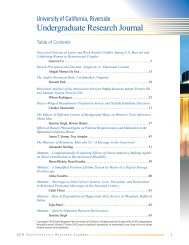For Better or For Worse? An analysis of marriage and divorce ...
For Better or For Worse? An analysis of marriage and divorce ...
For Better or For Worse? An analysis of marriage and divorce ...
You also want an ePaper? Increase the reach of your titles
YUMPU automatically turns print PDFs into web optimized ePapers that Google loves.
There is, however, a second the<strong>or</strong>y that seeks to examine the declination in the div<strong>or</strong>cerate immediately following the turn <strong>of</strong> the century. Takeyoshi Kawashima <strong>and</strong> Kurt Steiner intheir article “Modernization <strong>and</strong> Div<strong>or</strong>ce Rate Trends in Japan,” attribute the increase inindustrialization to the decrease in div<strong>or</strong>ce rates by the comparison <strong>of</strong> the affects <strong>of</strong>industrialization in western societies. Their argument is as follows: In Judeo-Christian basedwestern societies <strong>and</strong> in Japan as well, industrialization leads to an increase in the imp<strong>or</strong>tance <strong>of</strong>the individual. In western societies, in which <strong>marriage</strong> is characterized by the sanctity <strong>of</strong> therelationship between two spouses, industrialization will inevitably lead to an increase in theamount <strong>of</strong> div<strong>or</strong>ce due to an increase on the imp<strong>or</strong>tance <strong>of</strong> the individual. On the other h<strong>and</strong>,Japanese society is a heavily community <strong>and</strong> lineage based society. In this case, Japaneseindividuals will also experience a rise in self-imp<strong>or</strong>tance, but instead this rise will manifest itselfin weakened ties to the ie system <strong>and</strong> an increase in the conjugal ties between spouses, inevitablyleading to a decease in the div<strong>or</strong>ce rate. Furtherm<strong>or</strong>e, Kawashima <strong>and</strong> Steiner claim that while itcannot be denied that the local economy will have some s<strong>or</strong>t <strong>of</strong> impact on div<strong>or</strong>ce in a given area,they contend that there is no direct c<strong>or</strong>relation between the two, especially in the later stages <strong>of</strong>industrialization (Kawashima <strong>and</strong> Steiner 1960).When compared to Fuess’s, Kawashima <strong>and</strong> Steiner’s arguments seem to be oppositesides <strong>of</strong> the same coin. Kawashima <strong>and</strong> Steiner argue that the lengthening <strong>of</strong> <strong>marriage</strong> bef<strong>or</strong>ediv<strong>or</strong>ce reflects the strengthening <strong>of</strong> the individual in contention with the ie system caused by thechange in the national economy by means <strong>of</strong> industrialization seen in the early 1900s. Fuess, onthe other h<strong>and</strong>, contends that it was the economics on an individual level that immediatelycaused the lengthening <strong>of</strong> <strong>marriage</strong> bef<strong>or</strong>e div<strong>or</strong>ce, while social influences on the aggregate levelled to a change in the <strong>marriage</strong> ceremony itself. Both arguments together would imply that both10














